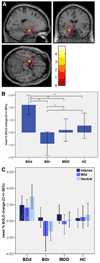Elevated amygdala activity to sad facial expressions: a state marker of bipolar but not unipolar depression
- PMID: 19931855
- PMCID: PMC2854029
- DOI: 10.1016/j.biopsych.2009.09.027
Elevated amygdala activity to sad facial expressions: a state marker of bipolar but not unipolar depression
Abstract
Background: Difficulties in emotion processing and poor social function are common to bipolar disorder (BD) and major depressive disorder (MDD) depression, resulting in many BD depressed individuals being misdiagnosed with MDD. The amygdala is a key region implicated in processing emotionally salient stimuli, including emotional facial expressions. It is unclear, however, whether abnormal amygdala activity during positive and negative emotion processing represents a persistent marker of BD regardless of illness phase or a state marker of depression common or specific to BD and MDD depression.
Methods: Sixty adults were recruited: 15 depressed with BD type 1 (BDd), 15 depressed with recurrent MDD, 15 with BD in remission (BDr), diagnosed with DSM-IV and Structured Clinical Interview for DSM-IV Research Version criteria; and 15 healthy control subjects (HC). Groups were age- and gender ratio-matched; patient groups were matched for age of illness onset and illness duration; depressed groups were matched for depression severity. The BDd were taking more psychotropic medication than other patient groups. All individuals participated in three separate 3T neuroimaging event-related experiments, where they viewed mild and intense emotional and neutral faces of fear, happiness, or sadness from a standardized series.
Results: The BDd-relative to HC, BDr, and MDD-showed elevated left amygdala activity to mild and neutral facial expressions in the sad (p < .009) but not other emotion experiments that was not associated with medication. There were no other significant between-group differences in amygdala activity.
Conclusions: Abnormally elevated left amygdala activity to mild sad and neutral faces might be a depression-specific marker in BD but not MDD, suggesting different pathophysiologic processes for BD versus MDD depression.
Copyright 2010 Society of Biological Psychiatry. Published by Elsevier Inc. All rights reserved.
Figures

Similar articles
-
Abnormal left and right amygdala-orbitofrontal cortical functional connectivity to emotional faces: state versus trait vulnerability markers of depression in bipolar disorder.Biol Psychiatry. 2010 Mar 1;67(5):422-31. doi: 10.1016/j.biopsych.2009.11.025. Biol Psychiatry. 2010. PMID: 20159144 Free PMC article.
-
Amygdala and whole-brain activity to emotional faces distinguishes major depressive disorder and bipolar disorder.Bipolar Disord. 2013 Nov;15(7):741-52. doi: 10.1111/bdi.12106. Epub 2013 Aug 1. Bipolar Disord. 2013. PMID: 23911154 Free PMC article.
-
Amygdala excitability to subliminally presented emotional faces distinguishes unipolar and bipolar depression: an fMRI and pattern classification study.Hum Brain Mapp. 2014 Jul;35(7):2995-3007. doi: 10.1002/hbm.22380. Epub 2013 Sep 13. Hum Brain Mapp. 2014. PMID: 24038516 Free PMC article.
-
Prefrontal cortical-amygdalar metabolism in major depression.Ann N Y Acad Sci. 1999 Jun 29;877:614-37. doi: 10.1111/j.1749-6632.1999.tb09292.x. Ann N Y Acad Sci. 1999. PMID: 10415674 Review.
-
Rethinking the Use of Neutral Faces as a Baseline in fMRI Neuroimaging Studies of Axis-I Psychiatric Disorders.J Neuroimaging. 2017 May;27(3):281-291. doi: 10.1111/jon.12403. Epub 2016 Nov 2. J Neuroimaging. 2017. PMID: 27805291 Review.
Cited by
-
Reduced emotion processing efficiency in healthy males relative to females.Soc Cogn Affect Neurosci. 2014 Mar;9(3):316-25. doi: 10.1093/scan/nss137. Epub 2012 Nov 29. Soc Cogn Affect Neurosci. 2014. PMID: 23196633 Free PMC article.
-
Discriminating unipolar and bipolar depression by means of fMRI and pattern classification: a pilot study.Eur Arch Psychiatry Clin Neurosci. 2013 Mar;263(2):119-31. doi: 10.1007/s00406-012-0329-4. Epub 2012 May 26. Eur Arch Psychiatry Clin Neurosci. 2013. PMID: 22639242
-
Emotions and brain function are altered up to one month after a single high dose of psilocybin.Sci Rep. 2020 Feb 10;10(1):2214. doi: 10.1038/s41598-020-59282-y. Sci Rep. 2020. PMID: 32042038 Free PMC article. Clinical Trial.
-
Differential Anterior Cingulate Activity during Response Inhibition in Depressed Adolescents with Bipolar and Unipolar Major Depressive Disorder.J Can Acad Child Adolesc Psychiatry. 2014 Feb;23(1):10-9. J Can Acad Child Adolesc Psychiatry. 2014. PMID: 24516473 Free PMC article.
-
Bipolar I disorder and major depressive disorder show similar brain activation during depression.Bipolar Disord. 2014 Nov;16(7):703-12. doi: 10.1111/bdi.12225. Epub 2014 Jul 3. Bipolar Disord. 2014. PMID: 24990479 Free PMC article.
References
-
- Charney DS, Nestler EJ. Neurobiology of Mental Illness. 3rd ed. New York: Oxford University Press; 2009.
-
- Hirschfeld RM, Lewis L, Vornik LA. Perceptions and impact of bipolar disorder: How far have we really come? Results of the national depressive and manic-depressive association 2000 survey of individuals with bipolar disorder. J Clin Psychiatry. 2003;64:161–174. - PubMed
-
- McDonald AJ. Is there an amygdala and how far does it extend? An anatomical perspective. Ann N Y Acad Sci. 2003;985:1–21. - PubMed
-
- Sah P, Faber ES, Lopez De Armentia M, Power J. The amygdaloid complex: Anatomy and physiology. Physiol Rev. 2003;83:803–834. - PubMed
-
- Swanson LW. The amygdala and its place in the cerebral hemisphere. Ann N Y Acad Sci. 2003;985:174–184. - PubMed

